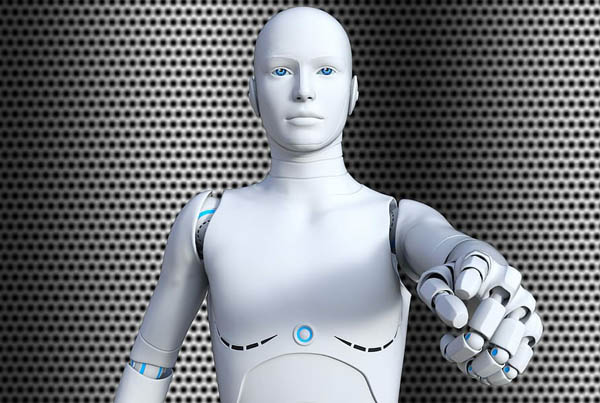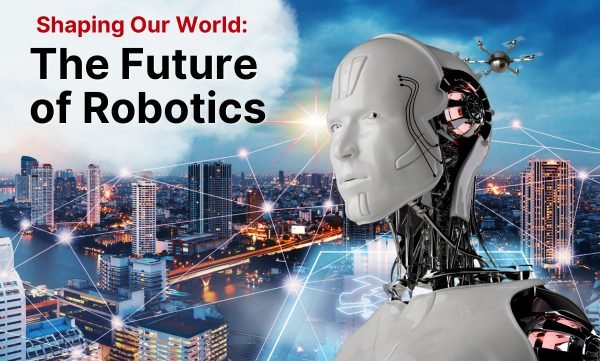Robots and computer technology are utilized in the field of engineering and science referred to as robotics. It involves the development, engineering, manipulation, and utilization of robotics and computer systems to enable control, sensory feedback, and data analysis. In this article, we will explore the future of robotics, the latest developments, and the impact it is expected to have on society.
Popular applications of robotics include industrial automation, medical robotics technologies, military and security systems, as well as space exploration and disaster relief. The study of robot mechanics, artificial intelligence, control systems, and sensor technology is referred to as robotics.
Robotics has made excellent technological advances and has become increasingly important in several sectors in recent years.

Here are some key ways in which robotics has played a role:
- Industrial Automation: Robotics has revolutionized industrial processes by automating repetitive and labor-intensive tasks. Industrial robots are becoming more frequently used to increase productivity, improve efficiency, and ensure consistent quality in factories, warehouses, and assembly lines.
These robots can perform tasks such as welding, material handling, packaging, and even complex assembly operations.
- Healthcare and Medicine: Robotics has made remarkable contributions to healthcare and medicine. Surgical robots are now used in minimally invasive procedures, enabling surgeons to perform precise operations with smaller incisions, reduced blood loss, and faster recovery times. Robotic exoskeletons help recover movement and enhance the quality of life for individuals with movement disabilities. Robots also assist in tasks such as medication dispensing, patient monitoring, and rehabilitation therapy.
- Service and Hospitality: The service industry has witnessed the deployment of robots in various roles. For example, robots are employed in hotels for tasks like room service, cleaning, and concierge services. In restaurants, robots can be seen taking orders, serving food, and even cooking meals. These robots not only automate repetitive tasks but also provide unique and futuristic experiences for customers.
- Agriculture and Farming: Robotics has found applications in agriculture, addressing challenges such as labor shortages and increasing productivity. Robots can perform tasks like planting, harvesting, and monitoring crops. Drones equipped with sensors and cameras are used for crop surveillance, disease detection, and precision spraying of fertilizers and pesticides. Robotic milkers are employed on dairy farms to automate the milking process.
- Exploration and Research: Robotics has played a crucial role in space exploration and scientific research. Robotic rovers like NASA’s Mars rovers, Curiosity, and Perseverance, have provided valuable insights into the Red Planet. Self-driving drones and unmanned underwater vehicles (UUVs) are utilized for data collection, oceanographic research, and marine exploration.
Robots also assist in hazardous environments, such as nuclear power plants, where they can perform inspections and maintenance tasks.
- Education and Research: Robotics is speedily increased into the educational system to promote STEM ((Science, Technology, Engineering, and Mathematics) education. It allows students to develop their programming, critical thinking, and problem-solving skills.
Educational robots, such as LEGO Mindstorms and Arduino-based platforms, enable hands-on learning and inspire creativity.
These are just a few examples of how robotics is currently used. And about our future of robotics.
Artificial intelligence, machine learning, and sensor technology improvements are pushing more creativity in the field of robotics and creating new opportunities for robotic applications in a variety of fields and daily life.
Read Also:
1. Robotics for Kids
2. Online Coding Classes for Kids
3. Artificial Intelligence Classes for Kids
Advantages and disadvantages of robotics
Advantages:
- Increased Productivity: Robots can work non-stop and have greater accuracy than humans, leading to increased output and improved overall efficiency.
- Increased Safety: Robots can handle hazardous materials without risk of injury, making them ideal for use in dangerous environments.
- More Affordable: As technology becomes more advanced, robots become more affordable for businesses of all sizes.
- Reduced Human Error: Robotic automation reduces the potential for human error and provides a more predictable outcome.
Disadvantages:
- High Cost: The initial investment in robotics can be expensive.
- Limited Flexibility: Some robots are made to be able to do a variety of activities, while many are restricted to a defined range of movements or actions.
- Job Losses: As robots are used more often, they can replace workers, which may result in job losses.
- Complexity: Robotics can be complex and require significant technical training to maintain and troubleshoot.
The Future of Robotics
Robotics has made unknown advances in recent years thanks to the use of artificial intelligence (AI) technology. Robotics has significantly benefited from the growth of artificial intelligence (AI), which has changed how people understand and work with machines.
As we consider the future of robots, it’s becoming clear that AI is a key factor in determining the course of the currently increasing industry.
-
Enhancing Efficiency and precision through AI
AI gives devices the capacity to instantly and intelligently analyze huge amounts of data. This capability has revolutionized industrial automation, where robots equipped with AI algorithms can streamline complex manufacturing processes. By leveraging AI, robots can optimize production lines, detect defects with unmatched precision, and adapt to dynamic environments. This not only improves overall efficiency but also reduces errors and enhances the quality of output.
-
Enabling human-robot collaboration
AI-enabled robots are increasingly designed to work alongside humans, fostering a collaborative environment. Unlike traditional industrial robots, which are confined to cages for safety reasons, AI-powered robots can safely operate alongside human workers. These robots are equipped with advanced sensors and perception algorithms that enable them to recognize and respond to human gestures, making them invaluable assets in industries like healthcare, logistics, and even household assistance. By seamlessly integrating AI into robotics, we can create a harmonious synergy between humans and machines, augmenting our capabilities and productivity.
-
Advancing autonomy and adaptability
The ability of AI in robotics to provide autonomous decision-making and modification is one of its most outstanding features.
Robots can learn from their experiences and develop better performance over time thanks to machine learning and neural networks with deep connections. This enables them to navigate complex environments, handle unpredictable situations, and even learn new tasks. Whether it’s self-driving cars autonomously maneuvering through traffic or drones mapping uncharted territories, AI empowers robots to adapt and learn independently, enhancing their capabilities and expanding their potential applications.
-
Innovating Healthcare and Assistive Technologies
The integration of AI and robotics holds great promise in the healthcare industry. AI-powered robots can assist in surgical procedures, perform repetitive tasks with precision, and even provide companionship to patients in need. For instance, robotic exoskeletons can help individuals with limited mobility regain their independence by providing support and assistance in movement. Moreover, AI algorithms can analyze medical data to aid in diagnosis, treatment planning, and drug discovery, ultimately revolutionizing the way healthcare is delivered.
-
Transforming industries and job markets
As AI continues to reshape robotics, it will inevitably bring about transformations in industries and job markets. While some jobs may be automated, new opportunities emerge as a result of this paradigm shift. Job roles like robotics engineers, AI specialists, and automation technicians are becoming increasingly crucial. By upskilling and adapting to this new technological landscape, individuals can seize the opportunities presented by AI in robotics and contribute to the future workforce.
In conclusion, this is the future of robotics, the combination of AI and robots bringing in a new era of invention and opportunity. AI has become a crucial element in determining the direction of robotics, from improving productivity and accuracy to allowing human-robot collaboration, developing autonomy, and revolutionizing sectors. It needs ongoing study, development, and collaboration amongst specialists from diverse fields to adapt to this AI-driven future. We can open up infinite opportunities and revolutionize numerous industries by utilizing the power of AI and robots, which will ultimately lead to a more advanced and automated society.




